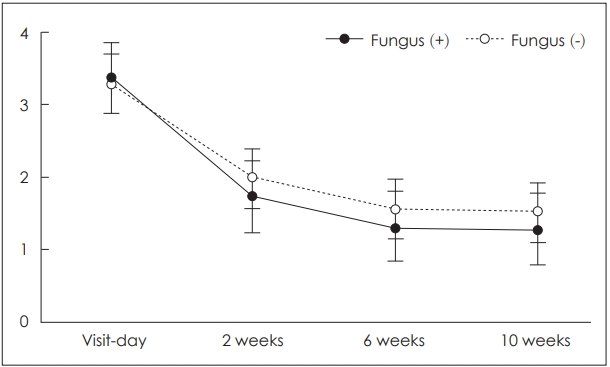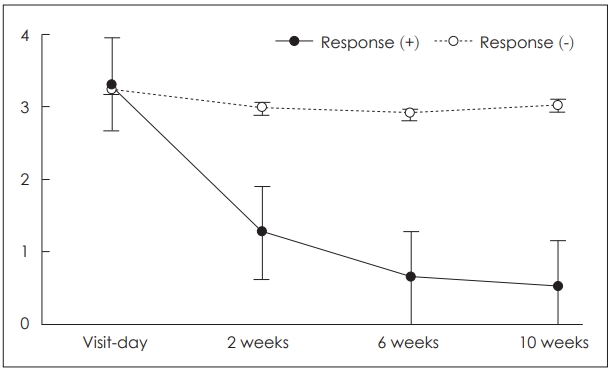ņä£ ļĪĀ
ĻĄ¼Ļ░Ģ ņ×æņŚ┤Ļ░É ņ”ØĒøäĻĄ░(burning mouth syndrome)ņØĆ ĻĄ¼Ļ░ĢņØś ļÜ£ļĀĘĒĢ£ ļ│æļ│Ć ņŚåņØ┤ ĻĄ¼Ļ░Ģ ļé┤ņØś ĒåĄņ”ØĻ│╝ ļČłĒÄĖĻ░ÉņØä ĒśĖņåīĒĢśļŖö ņ¦łĒÖśņØ┤ļŗż[1]. ĻĄ¼Ļ░Ģ ņ×æņŚ┤Ļ░É ņ”ØĒøäĻĄ░ņØä ņĢōļŖö ĒÖśņ×ÉļōżņØĆ ļŗżņ¢æĒĢ£ ņĀĢļÅäņØś ņ”ØņāüņØä ĒśĖņåīĒĢśļ®░ ļīĆĻ░£ ĒÖśņ×ÉņØś ņĀäņŗĀ ņāüĒā£ Ēś╣ņØĆ ņŗ¼ļ”¼ņĀü ņÜöņØĖĻ│╝ ņŚ░Ļ┤ĆņØ┤ ņ׳ļŖö Ļ▓āņ£╝ļĪ£ ņĢīļĀżņĀĖ ņ׳ļŗż[2-4]. ĻĄ¼Ļ░Ģ ņ×æņŚ┤Ļ░É ņ”ØĒøäĻĄ░ņŚÉļŖö ĒåĄņØ╝ļÉ£ ĻĖ░ņżĆņØ┤ ņŚåĻĖ░ ļĢīļ¼ĖņŚÉ ņ¦äļŗ©ņØ┤ ņ¢┤ļĀĄĻ│Ā, ņŚ░ĻĄ¼ņ¦äņŚÉ ļö░ļØ╝ ņä£ļĪ£ ļŗżļźĖ ņŚŁĒĢÖ ņĪ░ņé¼ Ļ▓░Ļ│╝Ļ░Ć ļéśĒāĆļéśĻĖ░ļÅä ĒĢ£ļŗż[1,5,6].
ĻĄ¼Ļ░Ģ ņ×æņŚ┤Ļ░É ņ”ØĒøäĻĄ░ņŚÉļŖö ļŗżņ¢æĒĢ£ ņøÉņØĖ ļ░Å ņĢģĒÖö ņÜöņØĖņØ┤ Ļ┤ĆļĀ©ļÉśņ¢┤ ņ׳ņ£╝ļ®░, ņĀäņŗĀ ņØĖņ×É[7,8], ĻĄŁņåīņĀü ņØĖņ×É[7,9-12], ņŖżĒŖĖļĀłņŖż ļ░Å ņÜ░ņÜĖņ”ØĻ│╝ Ļ░ÖņØĆ ņŗ¼ļ”¼ņĀü ņÜöņØĖņØ┤ ņŚ░Ļ┤ĆļÉśņ¢┤ ņ׳ļŖö Ļ▓āņ£╝ļĪ£ ņĢīļĀżņĀĖ ņ׳ļŗż[3,10,11,13-16]. ĒĢśņ¦Ćļ¦ī ņ¢┤ļ¢ĀĒĢ£ ņÜöņåīĻ░Ć ĻĄ¼Ļ░Ģ ņ×æņŚ┤Ļ░É ņ”ØĒøäĻĄ░ņØś ļ░£ļ│æņŚÉ ļ│æļ”¼ĒĢÖņĀüņ£╝ļĪ£ ņŚ░Ļ┤ĆļÉśņ¢┤ ņ׳ņ¦ĆļŖö ņŚ¼ņĀäĒ׳ ļ¬ģĒÖĢĒĢśņ¦Ć ņĢŖļŗż. ļö░ļØ╝ņä£ Ēśäņ×¼ ĻĄ¼Ļ░Ģ ņ×æņŚ┤Ļ░É ņ”ØĒøäĻĄ░ņØś ņ╣śļŻīļŖö ņ¦łĒÖśĻ│╝ Ļ┤ĆļĀ©ļÉ£ ļŗżņ¢æĒĢ£ ņØĖņ×Éļź╝ ņĪ░ņĀłĒĢśĻ│Ā ĒÖśņ×ÉĻ░Ć ĒśĖņåīĒĢśļŖö ņ”ØņāüņØä Ļ░Éņåīņŗ£ĒéżļŖö Ļ▓āņØä ļ¬®ņĀüņ£╝ļĪ£ ĒĢśĻ│Ā ņ׳ļŗż.
ņĢäņ¦üĻ╣īņ¦Ć ĻĄ¼Ļ░Ģ ņ×æņŚ┤Ļ░É ņ”ØĒøäĻĄ░ņØś ņ╣śļŻīņŚÉ ņŖ╣ņØĖļÉ£ ņĢĮļ¼╝ņØĆ ņŚåņ£╝ļéś trazodone, paroxetine, clonazepam, gabapentinņØ┤ 50% ņØ┤ņāüņØś ĒÖśņ×ÉņŚÉņä£ ĒÜ©Ļ│╝Ļ░Ć ņ׳ļŖö Ļ▓āņ£╝ļĪ£ ņŚ¼ļ¤¼ ņŚ░ĻĄ¼ņŚÉņä£ ļ│┤Ļ│ĀļÉśņŚłļŗż[17-20]. ĻĄŁņåī ņ╣śļŻī ņÜöļ▓Ģņ£╝ļĪ£ļŖö a lpha lipoic acidļź╝ ņé¼ņÜ®ĒĢśņŚ¼ ņĢĮ 50~97% [16,21], steroid gargleņØä ņé¼ņÜ®ĒĢśņŚ¼ ņĢĮ 50% [16], benzydamine gargleņØä ņé¼ņÜ®ĒĢśņŚ¼ 10% [22], systemic capsaicinņØä ņé¼ņÜ®ĒĢśņŚ¼ 76% [23], topical clonazepamņØä ņé¼ņÜ®ĒĢśņŚ¼ 52~76%ņØś ĒÜ©Ļ│╝ļź╝ Ļ▒░ļæÉņŚłļŗżĻ│Ā ĒĢśļŖö ļŗżņłśņØś ņŚ░ĻĄ¼ Ļ▓░Ļ│╝Ļ░Ć ņ׳ņŚłļŗż[23,24].
ļŗżļźĖ ņŚ░ĻĄ¼ļōżņŚÉņä£ļŖö ĻĄ¼Ļ░Ģ ņ║öļööļŗżņ”ØņØ┤ ņäżĒåĄ ļ░Å ĻĄ¼Ļ░Ģ ņ×æņŚ┤Ļ░ÉņØ┤ ņøÉņØĖņØ┤ ļÉĀ ņłś ņ׳ņ£╝ļ®░, ĻĄ¼Ļ░Ģ ņ×æņŚ┤Ļ░É ņ”ØĒøäĻĄ░ ĒÖśņ×ÉņÖĆ ļīĆņĪ░ĻĄ░ņØä ļ╣äĻĄÉĒĢśņśĆņØä ļĢī ņ¦äĻĘĀ ļ░░ņ¢æ Ļ▓Ćņé¼ ņ¢æņä▒ļźĀņØ┤ ņ£ĀņØśļ»ĖĒĢśĻ▓ī ļåÆļŗżļŖö ņŚ░ĻĄ¼ Ļ▓░Ļ│╝ļź╝ ļ│┤Ļ│ĀĒĢśĻ│Ā ņ׳ņŚłļŗż[25,26]. ĒĢśņ¦Ćļ¦ī ņ¦äĻĘĀ ņ╣śļŻīņØś ĒÜ©ņÜ®ņä▒ņŚÉ ļīĆĒĢ┤ņä£ļŖö ņØ┤Ļ▓¼ņØ┤ ņ׳ņŚłņ£╝ļ®░ TeraiņÖĆ Shimahara [25]ļŖö ņ¦äĻĘĀ ņ╣śļŻī Ēøä ņ”ØņāüņØś ļÜ£ļĀĘĒĢ£ ĒśĖņĀäņØ┤ ņ׳ņØīņØä ļ│┤Ļ│ĀĒĢśņśĆņ£╝ļéś, Park ļō▒[26]ņØĆ ņ¦äĻĘĀ ļ░░ņ¢æņŚÉņä£ ņ¢æņä▒ņØĖ ĒÖśņ×ÉļōżņŚÉĻ▓ī ņ¦äĻĘĀ ņ╣śļŻīļź╝ ņŗ£Ē¢ēĒĢśņśĆņØīņŚÉļÅä ņ”Øņāü ĒśĖņĀäņŚÉ ņ£ĀņØśĒĢ£ ņśüĒ¢źņØĆ ņŚåņŚłņØīņØä ļ│┤Ļ│ĀĒĢśņśĆļŗż. ļö░ļØ╝ņä£ ņĀĆņ×ÉļōżņØĆ ĻĄ¼Ļ░Ģ ļé┤ ņ║öļööļŗżņÖĆ Ļ░ÖņØĆ ņ¦äĻĘĀ Ļ░ÉņŚ╝ņØ┤ ĻĄ¼Ļ░Ģ ņ×æņŚ┤Ļ░É ņ”ØĒøäĻĄ░Ļ│╝ ņŚ░Ļ┤ĆņØ┤ ņ׳ļŗżļŖö Ļ▓āņŚÉ ņŻ╝ļ¬®ĒĢśņŚ¼, ĻĄ¼Ļ░Ģ ņ×æņŚ┤Ļ░É ņ”ØĒøäĻĄ░ņ£╝ļĪ£ ņ¦äļŗ©ļÉ£ ĒÖśņ×ÉļōżņŚÉ ļīĆĒĢ£ ĻĄŁņåī ĒĢŁņ¦äĻĘĀņĀ£ņØś ĒÜ©ņÜ®ņä▒ņØä ņĢīņĢäļ│┤Ļ│Āņ×É ĒĢśņśĆļŗż.
ļīĆņāü ļ░Å ļ░®ļ▓Ģ
2014~2019ļģäĻ╣īņ¦Ć 6ļģäĻ░ä ņ┤Ø 358ļ¬ģņØś ĒÖśņ×ÉĻ░Ć ĻĄ¼Ļ░Ģ ļé┤ ĒåĄņ”ØņØä ņŻ╝ņåīļĪ£ ļé┤ņøÉĒĢśņśĆļŗż. ņØ┤ ņżæņŚÉņä£ ĻĄ¼Ļ░Ģ ņ×æņŚ┤Ļ░É ņ”ØĒøäĻĄ░ņ£╝ļĪ£ ņ¦äļŗ©ļÉ£ Ēøä 10ņŻ╝ņØś ņÖĖļל ņČöņĀü Ļ┤Ćņ░░ ļ░Å ĻĄŁņåī ĒĢŁņ¦äĻĘĀņĀ£ Ļ░ĆĻĖĆ ļŗ©ļÅģ ņ╣śļŻīļź╝ ļ░øņØĆ ĒÖśņ×Éļź╝ ņŚ░ĻĄ¼ņŚÉ ĒżĒĢ©ĒĢśņśĆņ£╝ļ®░, ĻĄ¼Ļ░Ģ ļé┤ ņØ┤ņāüļ│æļ│ĆņØ┤ ļ░£Ļ▓¼ļÉśĻ▒░ļéś ņ╣śļŻī ĻĖ░Ļ░ä ņżæ ņČöņĀü ņåīņŗżļÉ£ ĒÖśņ×ÉļōżņØĆ ņŚ░ĻĄ¼ļīĆņāüņŚÉņä£ ņĀ£ņÖĖĒĢśņśĆļŗż. ĻĄ¼Ļ░Ģ ņ×æņŚ┤Ļ░É ņ”ØĒøäĻĄ░ņØĆ ĻĄŁņĀ£ļæÉĒåĄņ¦łĒÖśļČäļźś ņĀ£3ĒīÉ(International Classification of Headache Disorders-3)ņØś ņ¦äļŗ© ĻĖ░ņżĆņŚÉ ļö░ļØ╝, ļÜ£ļĀĘĒĢ£ ĻĄ¼Ļ░Ģ ļé┤ ļ│æļ│Ć ņŚåņØ┤, 3Ļ░£ņøö ņØ┤ņāüņØś ĻĖ░Ļ░ä ļÅÖņĢł, ĒĢśļŻ© 2ņŗ£Ļ░ä ņØ┤ņāü ņ¦ĆņåŹļÉśļŖö ĻĄ¼Ļ░Ģ ļé┤ ņ×æņŚ┤Ļ░É ļśÉļŖö ļČłĒÄĖĻ░ÉņØä ĒśĖņåīĒĢśļŖö Ļ▓ĮņÜ░ļĪ£ ņĀĢņØśĒĢśņśĆļŗż[27]. ņ┤Ø 166ļ¬ģņØś ĒÖśņ×ÉĻ░Ć ņŚ░ĻĄ¼ņŚÉ ĒżĒĢ©ļÉśņŚłļŗż. ņŚ░ĻĄ¼ņŚÉ ĒżĒĢ©ļÉ£ ĒÖśņ×ÉņŚÉņä£ ĒśłņĢĪ Ļ▓Ćņé¼ļŖö complete blood count, electrolyte, AST, ALT, BUN, creatinine, ZnņØä ņŗ£Ē¢ēĒĢśņśĆņ£╝ļ®░, ĻĄ¼Ļ░Ģ ļé┤ ņäĖĻĘĀ ļ░░ņ¢æ Ļ▓Ćņé¼ņÖĆ ņ¦äĻĘĀ ļ░░ņ¢æ Ļ▓Ćņé¼ļź╝ ņŗ£Ē¢ēĒĢśņśĆļŗż. ļśÉĒĢ£, ļÅÖļ░ś ņ¦łĒÖś, ļ│ĄņÜ®ĒĢśļŖö ņĢĮļ¼╝, ĒØĪņŚ░ļĀź, ņĀĢņŗĀņ¦łĒÖś ļ│æļĀźņØä ņĪ░ņé¼ĒĢśņśĆļŗż.
ņ╣śļŻīļŖö nystatin(Nystatin Oral Suspension, 10ļ¦ī iu/mL, Pharmascience Inc., Montreal, Canada) 5 mLļź╝ 3ļČäĻ░ä ņ×ģ ņĢłņŚÉ ļ©ĖĻĖłĻ│Ā ņ׳ļŗżĻ░Ć ļ▒ēļŖö ņŗØņ£╝ļĪ£ 1ņØ╝ 3ĒÜī 2ņŻ╝Ļ░ä ņŗ£Ē¢ēĒĢśņśĆņ£╝ļ®░, ņ╣śļŻī ņŗ£ņ×æ Ēøä 2, 6, 10ņŻ╝ņŚÉ ņÖĖļל ņČöņĀü Ļ┤Ćņ░░ņØä ĒĢśņśĆļŗż. ņ”Øņāü ĒÅēĻ░ĆļŖö 0-to-4 verbal rating scale(VRS-4) ĒåĄņ”Ø ņ▓ÖļÅäļź╝ ņé¼ņÜ®ĒĢśņśĆņ£╝ļ®░, ļ¼┤ĒåĄņ”Ø(0ņĀÉ), Ļ▓ĮļÅäņØś ĒåĄņ”Ø(1ņĀÉ), ņżæļō▒ļÅäņØś ĒåĄņ”Ø(2ņĀÉ), ņŗ¼ĒĢ£ ĒåĄņ”Ø(3ņĀÉ), ņ░ĖņØä ņłś ņŚåļŖö ĒåĄņ”Ø(4ņĀÉ)ņ£╝ļĪ£ ļČäļźśĒĢśņśĆļŗż. ņ╣śļŻīņØś ņä▒Ļ│ĄņØĆ ņ▓½ ļé┤ņøÉ Ēøä 10ņŻ╝ ļÆż ņŗ£Ē¢ēĒĢ£ ĒåĄņ”Ø ņ▓ÖļÅä Ļ▓Ćņé¼ņŚÉņä£ 1ņĀÉ ņØ┤ĒĢśņØś ĒåĄņ”ØņØä ĒśĖņåīĒĢ£ Ļ▓ĮņÜ░ļĪ£ ņĀĢĒĢśņśĆļŗż.
SPSS 22.0(IBM Corp., Armonk, NY, USA)ņØä ņØ┤ņÜ®ĒĢśņŚ¼ ĒÅēĻĘĀ ļČäņäØņØä ĒåĄĒĢśņŚ¼ ĻĄŁņåī ĒĢŁņ¦äĻĘĀņĀ£ Ļ░ĆĻĖĆ ņ╣śļŻīņØś ĒÜ©Ļ│╝ļź╝ ļČäņäØĒĢśņśĆņ£╝ļ®░, ņØ┤ļ│Ćļ¤ē ļĪ£ņ¦ĆņŖżĒŗ▒ ĒÜīĻĘĆ ļČäņäØņØä ĒåĄĒĢśņŚ¼ ņä▒ļ│ä, ņØīņŻ╝, ĒØĪņŚ░ ņŚ¼ļČĆ ļ░Å ļÅÖļ░śļÉ£ ņ¦łĒÖśĻ│╝ ĻĄŁņåī ĒĢŁņ¦äĻĘĀņĀ£ Ļ░ĆĻĖĆ ņ╣śļŻī ĒÜ©Ļ│╝ņŚÉ ļīĆĒĢ£ ļ░śņØæņØś ņŚ░Ļ┤Ćņä▒ņØä ļČäņäØĒĢśņśĆļŗż.
ļ│Ė ņŚ░ĻĄ¼ļŖö Ļ│ĀļĀżļīĆĒĢÖĻĄÉ ņĢłņĢöļ│æņøÉ ņāØļ¬ģņ£żļ”¼ņŗ¼ņØśņ£äņøÉĒÜīņØś Ļ▓ĆĒåĀņÖĆ ņŖ╣ņØĖņØä ļ░øņĢśļŗż(ņŖ╣ņØĖļ▓łĒśĖ: 2019AN0342).
Ļ▓░ Ļ│╝
ņŚ░ĻĄ¼ņŚÉ ĒżĒĢ©ļÉ£ ĒÖśņ×É ņżæ 119ļ¬ģ(71.69%)ņØ┤ ņŚ¼ņä▒, 47ļ¬ģņØ┤ ļé©ņä▒ņØ┤ņŚłņ£╝ļ®░, ĒÅēĻĘĀ ņŚ░ļĀ╣ņØĆ 64.1ņäĖņśĆļŗż. ņØīņŻ╝ļź╝ ĒĢśņ¦Ć ņĢŖĻ▒░ļéś, Ļ▒░ņØś ĒĢśņ¦Ć ņĢŖļŖö ĒÖśņ×ÉļŖö 142ļ¬ģņØ┤ņŚłņ£╝ļ®░, ļŗ┤ļ░░ļź╝ Ēö╝ņÜ░ņ¦Ć ņĢŖļŖö ĒÖśņ×ÉļŖö 143ļ¬ģņØ┤ņŚłļŗż. ļÅÖļ░śļÉ£ ņ¦łĒÖśņØĆ Ļ│ĀĒśłņĢĢņØ┤ 70ļ¬ģņŚÉņä£ ļÅÖļ░śļÉśņ¢┤ Ļ░Ćņן ĒØöĒĢśĻ▓ī ļÅÖļ░śļÉ£ ņ¦łĒÖśņ£╝ļĪ£ ĒÖĢņØĖļÉśņŚłņ£╝ļ®░, ļŗ╣ļć©ļŖö 23ļ¬ģņŚÉņä£ ļÅÖļ░śļÉśņŚłņ£╝ļ®░, ņÜ░ņÜĖņ”Ø ļ░Å ļČłļ®┤ņ”Ø ļō▒ņØś ņĀĢņŗĀņ¦łĒÖśņØĆ 22ļ¬ģņŚÉņä£ ļÅÖļ░śļÉśņŚłļŗż. ņĢäļ¼┤ļ¤░ ņ¦łĒÖśļÅä ļÅÖļ░śļÉśņ¦Ć ņĢŖņØĆ ĒÖśņ×ÉļŖö 64ļ¬ģņØ┤ņŚłļŗż(Table 1).
166ļ¬ģņØś ĒÖśņ×É ņżæņŚÉņä£ ņ┤Ø 103ļ¬ģ(62%)ņØś ĒÖśņ×ÉĻ░Ć ņ╣śļŻīņŚÉ ļ░śņØæņØ┤ ņ׳ļŖö Ļ▓āņ£╝ļĪ£ ĒÖĢņØĖļÉśņŚłļŗż. ļśÉĒĢ£ 63ļ¬ģņØś ĒÖśņ×ÉĻ░Ć ņ¦äĻĘĀ ļ░░ņ¢æ Ļ▓Ćņé¼ņŚÉņä£ ņ¦äĻĘĀ Ļ░ÉņŚ╝ņØ┤ ĒÖĢņØĖļÉśņŚłņ£╝ļ®░, ņØ┤ļŖö ņĀäņ▓┤ ĒÖśņ×ÉņØś 38%ņŚÉ ĒĢ┤ļŗ╣ĒĢśņśĆļŗż. ņ╣śļŻī ĻĖ░Ļ░ä ļÅÖņĢł ļ»ĖĻ░ü ļ│ĆĒÖö ļśÉļŖö ĒģüĒģüĒĢ© ļō▒ Ļ░ĆĻĖĆ ņ╣śļŻīļĪ£ ņØĖĒĢ┤ Ļ░ĆļŖźĒĢ£ ļČłĒÄĖĻ░ÉņØ┤ ļéśĒāĆļé£ ņé¼ļĪĆļŖö ņŚåņŚłļŗż. ĒåĄņ”ØņØś Ļ░ÉņåīļŖö ņ¦äĻĘĀ ļ░░ņ¢æ Ļ▓Ćņé¼ņŚÉņä£ ņ¦äĻĘĀņØ┤ ĒÖĢņØĖļÉ£ ĒÖśņ×É ņżæ 65%ņŚÉņä£, ņ¦äĻĘĀņØ┤ ĒÖĢņØĖļÉśņ¦Ć ņĢŖņØĆ ĒÖśņ×É ņżæ 61%ņŚÉņä£ ĒÖĢņØĖļÉśņŚłņ£╝ļ®░, ņ╣śļŻī ņĀäĻ│╝ ņ╣śļŻī Ēøä ĒåĄņ”Ø ņĀÉņłśļŖö ĒåĄĻ│äņĀü ņ£ĀņØśĒĢ£ ņ░©ņØ┤Ļ░Ć ĒÖĢņØĖļÉśņŚłļŗż(p’╝£0.0001)(Fig. 1). ņ╣śļŻī ĒÜ©Ļ│╝ļź╝ ļéśĒāĆļéĖ ĒÖśņ×ÉĻĄ░Ļ│╝ ņ╣śļŻī ĒÜ©Ļ│╝Ļ░Ć ļéśĒāĆļéśņ¦Ć ņĢŖņĢśņØä Ļ▓ĮņÜ░ļź╝ ļ╣äĻĄÉĒĢśņśĆņØä ļĢī, ņ╣śļŻī ĒÜ©Ļ│╝Ļ░Ć ļéśĒāĆļéśņ¦Ć ņĢŖņØĆ ĒÖśņ×ÉĻĄ░ņŚÉņä£ļŖö ņ┤łĻĖ░ ļé┤ņøÉĒĢĀ ļŗ╣ņŗ£ņÖĆ ļ╣äĻĄÉĒĢśņŚ¼ ĒåĄņ”Ø ņĀĢļÅäņŚÉ Ļ▒░ņØś ļ│ĆĒÖöĻ░Ć ņŚåņŚłņ£╝ļéś, ņ╣śļŻī ĒÜ©Ļ│╝Ļ░Ć ļéśĒāĆļé£ ĒÖśņ×ÉĻĄ░ņŚÉņä£ļŖö ĒåĄņ”Ø ņĀÉņłśĻ░Ć ņ╣śļŻī ĻĖ░Ļ░äņØ┤ ĻĖĖņ¢┤ņ¦ÉņŚÉ ļö░ļØ╝ ņĀÉņ¦äņĀüņ£╝ļĪ£ Ļ░ÉņåīĒĢśļŖö Ļ▓āņØ┤ ĒÖĢņØĖļÉśņŚłļŗż(Fig. 2).
ĒÖśņ×ÉņØś ĒåĄņ”Ø ĒÅēĻ░Ć ņĀÉņłś(VRS-4)ņŚÉ ĻĖ░ņ┤łĒĢśņŚ¼ ĒĢŁņ¦äĻĘĀņĀ£ņØś ņ╣śļŻī ņä▒Ļ│ĄņØä ņśłņĖĪĒĢśĻĖ░ ņ£äĒĢ£ cut-off pointĻ░ÆņØä Ļ▓░ņĀĢĒĢśĻĖ░ ņ£äĒĢ┤ receiver operating characteristic(ROC) Ļ│ĪņäĀņØä ĻĄ¼ĒśäĒĢśņśĆļŗż. ņ╣śļŻī ņŗ£ņ×æ Ēøä 2ņŻ╝Ļ░Ć ļÉ£ ĒÖśņ×ÉņØś ĒåĄņ”Ø ĒÅēĻ░Ć ņĀÉņłśņŚÉ ļīĆĒĢ£ ROC Ļ│ĪņäĀņØś Ļ│ĪņäĀ ļ░æ ļ®┤ņĀü area under the curveļŖö 0.873ņØ┤ņŚłļŗż. ņ╣śļŻī ņŗ£ņ×æ Ēøä 2ņŻ╝ ļÆż ņ╣śļŻī ņä▒Ļ│ĄņØä ņśłņĖĪĒĢśĻĖ░ņ£äĒĢ£ ĒåĄņ”ØĒÅēĻ░Ć ņĀÉņłśņØś cut-off pointĻ░ÆņØĆ 2ņĀÉņØ┤ņŚłņ£╝ļ®░ 88.5%ņØś ļ»╝Ļ░ÉļÅäņÖĆ 83.9%ņØś ĒŖ╣ņØ┤ļÅäļź╝ ļéśĒāĆļé┤ņŚłļŗż(Fig. 3).
ņ╣śļŻī ņĀäņŚÉ ņ╣śļŻī ĒÜ©Ļ│╝ļź╝ ņśłņĖĪĒĢĀ ņłś ņ׳ļŖö ņÜöņØĖņØä ņĢīņĢäļ│┤Ļ│Āņ×É ņä▒ļ│ä, ņØīņŻ╝, ĒØĪņŚ░, ļÅÖļ░śļÉ£ ņ¦łĒÖśņŚÉ ļö░ļØ╝ ĒÖśņ×ÉĻĄ░ņØä ļČäļźśĒĢśņŚ¼ ņ╣śļŻīņŚÉ ļ░śņØæņØä ļ│┤ņØĖ ĒÖśņ×ÉņØś ļ╣äņ£©ņØä ļ╣äĻĄÉĒĢśņśĆņØä ļĢī, ņ¢┤ļ¢ĀĒĢ£ ņÜöņØĖļÅä ĒĢŁņ¦äĻĘĀņĀ£ņŚÉ ļīĆĒĢ£ ļ░śņØæņØä ņśłņĖĪĒĢśļŖö ļŹ░ ļÅäņøĆņØä ņŻ╝ņ¦Ć ņĢŖļŖö Ļ▓āņ£╝ļĪ£ ĒÖĢņØĖļÉśņŚłļŗż(Table 2).
Ļ│Ā ņ░░
ĻĖ░ņĪ┤ ņŚ░ĻĄ¼ļōżņØä ĒåĄĒĢśņŚ¼ paroxetine, clonazepam, gabapentinĻ│╝ Ļ░ÖņØĆ ņŗĀĻ▓ĮņĢłņĀĢņĀ£ Ēś╣ņØĆ ĒĢŁņÜ░ņÜĖņĀ£ ļ│ĄņÜ®ņØ┤ ĻĄ¼Ļ░Ģ ņ×æņŚ┤Ļ░É ņ”ØĒøäĻĄ░ņØś ņ”ØņāüņØä ņĪ░ņĀłĒĢśļŖö ļŹ░ ļÅäņøĆņØ┤ ļÉśļŖö Ļ▓āņ£╝ļĪ£ ņĢīļĀżņĀĖ ņ׳ļŗż. ņØ┤ļ¤¼ĒĢ£ ņĢĮļ¼╝ļōżņØä ņé¼ņÜ®ĒĢśņŚ¼ ĻĄ¼Ļ░Ģ ņ×æņŚ┤Ļ░É ņ”ØĒøäĻĄ░ņØä ņ╣śļŻīĒĢ£ ļŗżļźĖ ņŚ░ĻĄ¼ļōżņØś Ļ▓░Ļ│╝ļź╝ ļ│┤ļ®┤ paroxetineņØĆ 66.7%ņØś ĒÖśņ×ÉņŚÉņä£, clonazepamņØĆ 57.1%ņØś ĒÖśņ×ÉņŚÉņä£, gabapentinņØä 85.7%ņØś ĒÖśņ×ÉņŚÉņä£ ņä▒Ļ│ĄņĀüņØĖ ņ╣śļŻī Ļ▓░Ļ│╝ļź╝ ĒÖĢņØĖĒĢĀ ņłś ņ׳ņŚłļŗżĻ│Ā ĒĢ£ļŗż[17-20]. ĒĢśņ¦Ćļ¦ī ņŗĀĻ▓ĮņĢłņĀĢņĀ£ļéś ĒĢŁņÜ░ņÜĖņĀ£ ļ│ĄņÜ®ņØĆ ļÅÖļ░śļÉ£ ņĀĢņŗĀņ¦łĒÖśņ£╝ļĪ£ ņØ┤ļ»Ė ĒĢ┤ļŗ╣ ņĢĮņĀ£ļź╝ ļ│ĄņÜ®ĒĢśļŖö ĒÖśņ×ÉļōżņŚÉņä£ ņé¼ņÜ®ĒĢśĻĖ░Ļ░Ć ņ¢┤ļĀżņøĆņØ┤ ņ׳ņ£╝ļ®░, ņ¦äņĀĢ, ļæÉļō£ļ¤¼ĻĖ░, ņ¢┤ņ¦Ćļ¤╝ ļō▒ ļŹö ņØ┤ņāü ņ╣śļŻīļź╝ ņ£Āņ¦ĆĒĢśĻĖ░ Ēלļōż ņĀĢļÅäņØś ļČĆņ×æņÜ®ņØä ĒśĖņåīĒĢśļŖö ĒÖśņ×ÉļōżņØ┤ ņ׳ļŖö Ļ▓āņ£╝ļĪ£ ļ│┤Ļ│ĀļÉśĻ│Ā ņ׳ļŗż[28]. ļ│Ė ņŚ░ĻĄ¼ņŚÉņä£ ņé¼ņÜ®ĒĢ£ ĻĄŁņåī ĒĢŁņ¦äĻĘĀņĀ£ Ļ░ĆĻĖĆņØĆ ņĢĮ 62%ņØś ĒÖśņ×ÉņŚÉņä£ ņ╣śļŻīņŚÉ ļ░śņØæņØä ļ│┤ņśĆņ£╝ļ®░, ņ¦äĻĘĀ ļ░░ņ¢æ Ļ▓Ćņé¼ņŚÉņä£ ņØīņä▒ņ£╝ļĪ£ ĒÖĢņØĖļÉ£ ĒÖśņ×ÉļōżņŚÉņä£ļÅä ņĢĮ 61% ĒÖśņ×ÉņŚÉņä£ ņ╣śļŻīņŚÉ ļ░śņØæņØä ļ│┤ņØ┤ļŖö Ļ▓āņ£╝ļĪ£ ĒÖĢņØĖļÉśņŚłļŗż. ņ¦äĻĘĀ Ļ▓Ćņé¼ņŚÉņä£ ņØīņä▒ņØ┤ ĒÖĢņØĖļÉ£ ĒÖśņ×ÉļōżņŚÉņä£ ņ╣śļŻīņŚÉ ļ░śņØæņØä ļ│┤ņØĖ Ļ▓āņØĆ ņ¦äĻĘĀ Ļ▓Ćņé¼ņØś ņ£äņØīņä▒ņŚÉ ņØśĒĢ£ Ļ▓āņ£╝ļĪ£ ņāØĻ░üļÉ£ļŗż. ņØ┤ļ▓ł ņŚ░ĻĄ¼ņŚÉ ņé¼ņÜ®ļÉ£ ņ¦äĻĘĀ ņŚ╝ņāē ļ░Å ņ¦äĻĘĀ ļ░░ņ¢æ Ļ▓Ćņé¼ņØś ņ£äņØīņä▒ļźĀņØĆ ņĢĮ 20~40%ņØĖ Ļ▓āņ£╝ļĪ£ ļ│┤Ļ│ĀļÉśĻ│Ā ņ׳ļŗż[29]. ļö░ļØ╝ņä£ ņĀĆņ×ÉļōżņØĆ ņ¦äĻĘĀ Ļ▓Ćņé¼ Ļ▓░Ļ│╝ņÖĆ ņāüĻ┤ĆņŚåņØ┤ ĻĄŁņåī ĒĢŁņ¦äĻĘĀņĀ£ļź╝ ņé¼ņÜ®ĒĢ┤ļ│┤ļŖö Ļ▓āņØ┤ ĻĄ¼Ļ░Ģ ņ×æņŚ┤Ļ░É ņ”ØĒøäĻĄ░ ĒÖśņ×ÉņØś ņ”ØņāüņØä Ļ▓ĮĻ░Éņŗ£ĒéżļŖö ļŹ░ ĒÜ©Ļ│╝Ļ░Ć ņ׳ļŖö Ļ▓āņ£╝ļĪ£ ņāØĻ░üļÉśņŚłļŗż. ĻĖ░ņĪ┤ņŚÉ ņØ╝ļ░śņĀüņ£╝ļĪ£ ņé¼ņÜ®ļÉśļŖö ņŗĀĻ▓ĮņĢłņĀĢņĀ£ ļ░Å ĒĢŁņÜ░ņÜĖņĀ£ļź╝ ņé¼ņÜ®ĒĢ£ Ļ▓ĮņÜ░ņÖĆ ļ╣äņŖĘĒĢ£ ņĀĢļÅäņØś ņ╣śļŻī ĒÜ©Ļ│╝ļź╝ ļ│┤ņØ┤Ļ│Ā ņ׳ņ£╝ļ®░, ņĢĮļ¼╝ ļ│ĄņÜ®ņ£╝ļĪ£ ņØĖĒĢ£ ņ¦äņĀĢ, ļæÉļō£ļ¤¼ĻĖ░, ņ¢┤ņ¦Ćļ¤╝ ļō▒ņØś ļČĆņ×æņÜ®ņØ┤ Ļ▒░ņØś ļ░£ņāØĒĢśņ¦Ć ņĢŖļŖöļŗżļŖö ņĀÉņŚÉņä£ ĻĄ¼Ļ░Ģ ņ×æņŚ┤Ļ░É ņ”ØĒøäĻĄ░ ņ╣śļŻīņŚÉ ņ£ĀņÜ®ņä▒ņØ┤ ņ׳ņØä Ļ▓āņ£╝ļĪ£ ņāØĻ░üļÉ£ļŗż.
ļŗżļ¦ī ĻĄŁņåī ĒĢŁņ¦äĻĘĀņĀ£ņŚÉ ļ░śņØæņØä ļ│┤ņØ┤ņ¦Ć ņĢŖļŖö ĒÖśņ×ÉļōżņØś 10ņŻ╝ Ļ░äņØś Ļ┤Ćņ░░ņŚÉ ļö░ļźĖ ĒåĄņ”Ø ņĀÉņłśņØś ļ│ĆĒÖöļź╝ ļ│┤ņĢśņØä ļĢī, ĻĄŁņåī ĒĢŁņ¦äĻĘĀņĀ£ Ļ░ĆĻĖĆ ņ╣śļŻīņŚÉ ļ░śņØæņØä ļ│┤ņØ┤ņ¦Ć ņĢŖļŖö ĒÖśņ×ÉļōżņØĆ ņ╣śļŻī ĻĖ░Ļ░äņØ┤ ĻĖĖņ¢┤ņ¦äļŗż ĒĢśļŹöļØ╝ļÅä ņ╣śļŻīņŚÉ Ļ▒░ņØś ļ░śņØæņØä ļ│┤ņØ┤ņ¦Ć ņĢŖļŖöļŗżļŖö Ļ▓āņØä ņĢī ņłś ņ׳ņŚłĻ│Ā, ņØ┤ļ¤¼ĒĢ£ ĒÖśņ×ÉļōżņŚÉ ļīĆĒĢ┤ņä£ļŖö ĻĖ░ņĪ┤ņŚÉ ņé¼ņÜ®ĒĢśļŖö ņ¦äĒåĄņĀ£ ļ░Å ņŗĀĻ▓ĮņĢłņĀĢņĀ£ Ēł¼ņŚ¼Ļ░Ć ĒĢäņÜöĒĢĀ Ļ▓āņ£╝ļĪ£ ņāØĻ░üļÉ£ļŗż. ļ│Ė ņŚ░ĻĄ¼ņØś ĒĢ£Ļ│äņĀÉņØĆ ņ╣śļŻī ĒÜ©Ļ│╝ ĒīÉņĀĢņŚÉ ņé¼ņÜ®ļÉ£ VRS-4 ĒåĄņ”Ø ņ▓ÖļÅäĻ░Ć ņ¦üĻ┤ĆņĀüņØ┤Ļ│Ā ņØ┤ĒĢ┤ĒĢśĻĖ░ ņē¼ņÜ░ļ®░, ĒÖśņ×ÉņØś Ēæ£ĒśäņŚÉ ĻĘ╝Ļ▒░ĒĢśĻĖ░ ļĢīļ¼ĖņŚÉ ņé¼ņÜ®ĒĢśĻĖ░ ņēĮļŗżļŖö ņןņĀÉņØ┤ ņ׳ņ¦Ćļ¦ī, ĒÖśņ×ÉņØś Ēæ£ĒśäņŚÉ ļö░ļØ╝ņä£ ĒåĄņ”Ø ņĀÉņłś ĒÅēĻ░ĆĻ░Ć ļŗżņåī ļ¬©ĒśĖĒĢĀ ņłś ņ׳ļŗżļŖö ļŗ©ņĀÉņØ┤ ņ׳ņ£╝ļ®░, ĻĄŁņåī ĒĢŁņ¦äĻĘĀņĀ£ļź╝ ņé¼ņÜ®ĒĢ£ ĒÖśņ×ÉĻĄ░ņŚÉ ļ╣äĻĄÉĒĢĀ ļīĆņĪ░ĻĄ░ņØ┤ ņĪ┤ņ×¼ĒĢśņ¦Ć ņĢŖļŖöļŗżļŖö ļŗ©ņĀÉņØ┤ ņ׳ļŗż. ļö░ļØ╝ņä£ Ē¢źĒøä ĻĄŁņåī ĒĢŁņ¦äĻĘĀņĀ£Ļ░Ć ĻĄ¼Ļ░Ģ ņ×æņŚ┤Ļ░É ņ”ØĒøäĻĄ░ņØś ņ╣śļŻīņŚÉ ņ¢┤ļŖÉ ņĀĢļÅäņØś ĒÜ©Ļ│╝ļź╝ Ļ░¢ļŖöņ¦Ćļź╝ ļ╣äĻĄÉĒĢśĻĖ░ ņ£äĒĢ£ ņĀäĒ¢źņĀüņØĖ ņŚ░ĻĄ¼Ļ░Ć ĒĢäņÜöĒĢĀ Ļ▓āņ£╝ļĪ£ ņāØĻ░üļÉ£ļŗż.

















